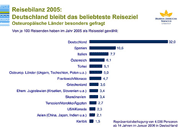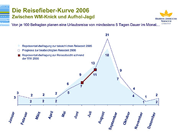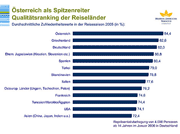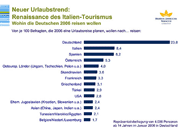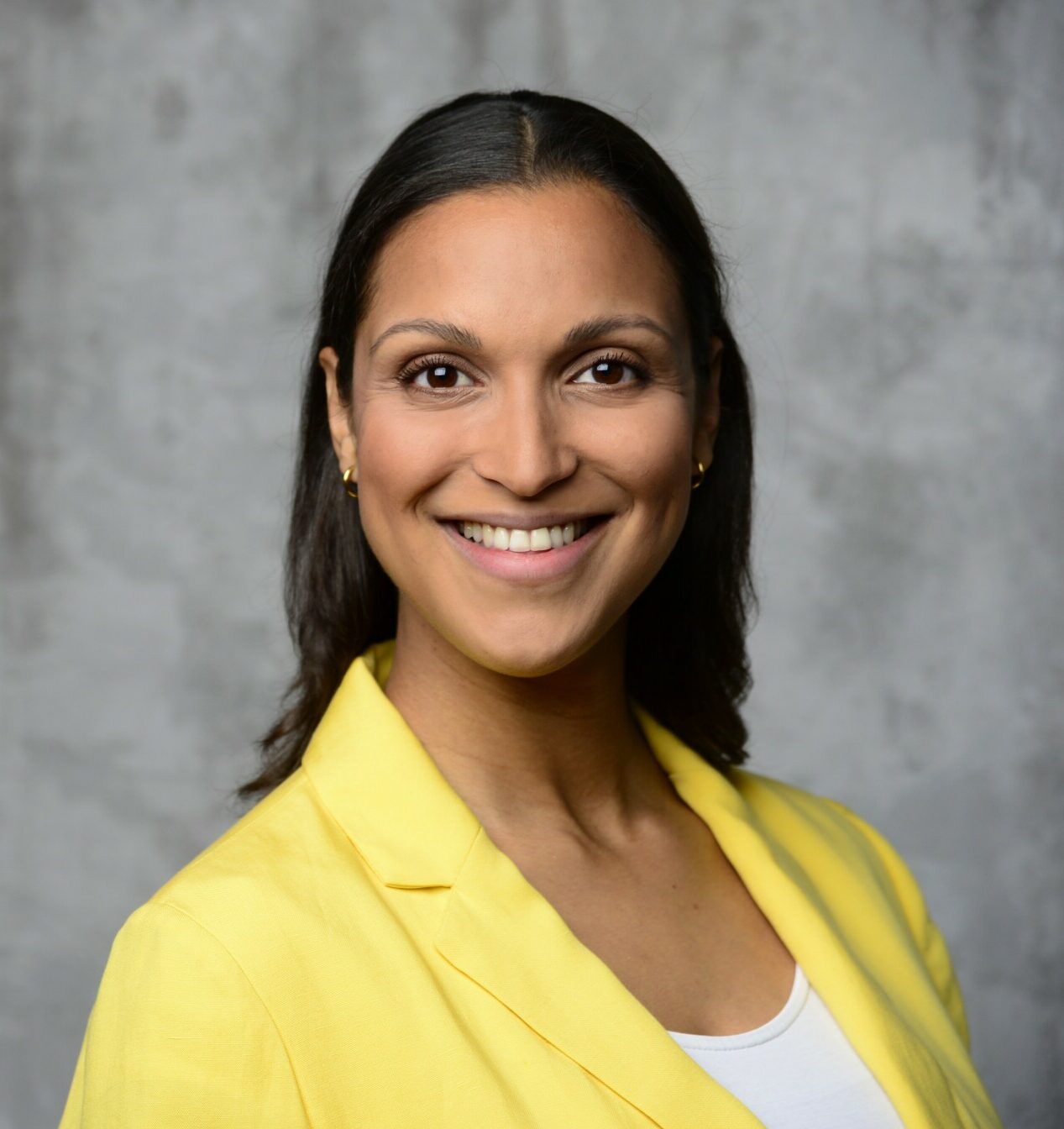22nd German Tourism Analysis
Growing desire to travel: Holidays are getting longer again.
Trend towards ever shorter trips stopped
Weak domestic demand and rising energy costs, the tsunami effect and the World Cup slump: At first glance, the upcoming travel season appears to pose an incalculable risk for the tourism industry. Quite the opposite is true: Germans are entering the new year with genuine optimism. Their desire to travel is growing, and the average trip duration is increasing again (2004: 12.8 days – 2005: 13.3 days). A good two-thirds of the population (68%) already have firm travel plans for 2006. And even World Cup fever cannot replace the travel bug: What the travel industry loses in vacationers during the World Cup will be made up for in a comeback after the tournament. This is according to the 22nd Tourism Analysis by the BAT Leisure Research Institute, in which 4,000 Germans aged 14 and over were surveyed about their vacation behavior in 2005 and their travel plans for 2006.
„A fundamental principle of the World Tourism Organization is proving true: Tourism recovers after every crisis,“ says Prof. Dr. Horst W. Opaschowski, head of the institute. „Tourists have a chronically short-term memory – especially when it comes to one-off events and natural disasters. After a year, almost everything is forgotten.“ Last year, almost two-thirds of German citizens (641,000) took a vacation of at least five days. Only 6 percent of the population opted for shorter trips of two to four days. And just under a third of the population (301,000) stayed home for their vacation.
Regarding the length of vacations, the downward trend is finally in sight. Since the 1980s, vacations have been getting shorter and shorter: from 18.2 days (1980) to 12.8 days in 2004. Last year, the trend toward ever shorter trips was halted. Opaschowski: "Clearly, the travel philosophy of taking the best weeks of the year is reaching its psychological limits when what was once an almost three-week relaxing vacation threatens to become just a short break of a few days. Weekend and short trips cannot replace the annual vacation." Especially city dwellers (14.6 days – rural residents: 11.2 days) are rediscovering the value of a longer vacation.
Domestic travel destinations 2005.
Bavaria remains in the lead, but domestic holidays are losing market share.
Germany remains the most popular holiday destination for Germans. However, domestic holidays are steadily losing popularity and market share – from 35 percent (1999) to 33 percent (2002) and down to 32 percent (2005). Back in the 1990s (1993 to 1996), domestic travel accounted for 41 percent of all trips. It is becoming increasingly difficult for domestic holiday regions to compete with foreign destinations and their allure of warmth, distant landscapes, and wide open spaces.
In domestic competition, Bavaria remains the leader (6.61 TP3T), closely followed by the holiday regions on the Baltic coast (6.31 TP3T) in Schleswig-Holstein and Mecklenburg-Western Pomerania, as well as the destinations on the North Sea (4.81 TP3T). Besides foreign competition, domestic holiday regions are increasingly facing internal competition. "In particular, the 'coast' and 'mountains' are vying for the favor of holidaymakers, who can reach Palma de Mallorca faster by budget airline than by car on Rügen or in the Bavarian mountains," says Professor Opaschowski. An end to the slump in domestic tourism is not yet in sight. The share of domestic trips has halved in recent decades – from 69 percent (1961) to 32 percent (2005).
Foreign travel destinations 2005.
Leaders lose, pursuers gain ground.
For years, Spain, Italy, Austria, and Turkey have been the undisputed top destinations for German tourists. This remained unchanged last year. Spain (10.6%) continues to lead, followed by Italy (7.7%), Austria (6.1%), and Turkey (5.1%). However, the chasing pack is closing in. This includes, in particular, the holiday regions in Croatia and Slovenia (3.4%) and in Eastern European countries such as Poland, Hungary, and Slovakia (5.0%), as well as destinations like Scandinavia (3.4%), Greece (3.6%), and France (4.7%). They are steadily approaching the leading group. At the same time, Austria is facing a challenge to its top position, having lost ground compared to the previous year, while Greece, France, Croatia, and Slovenia have seen significant increases.
Long-haul destinations are also trending again (2003: 61,000 – 2004: 81,000 – 2005: 111,000). The Caribbean, including Cuba and the Dominican Republic, is holding its own (2004: 1.51,000 – 2005: 1.51,000). Destinations in Asia, such as China, Japan, and India, are in higher demand (2004: 1.31,000 – 2005: 2.11,000). And the USA and Canada are also enjoying greater popularity (2004: 1.71,000 – 2005: 2.31,000). Opaschowski: "Long-haul destinations are on the rise, which also explains why the average trip duration is suddenly increasing again. Besides the necessary money, long-haul travel primarily requires time." In particular, singles (16.8%) and childless couples (16.1%) take more time for long-distance travel compared to the rest of the population (10.9%) and are also more likely to be able to afford this undertaking financially.
Tourism forecast 2006.
A sense of optimism prevails.
Looking optimistically into the new travel year!
A representative sample of 4,000 people aged 14 and over across Germany were surveyed about their travel plans for 2006. The survey results are surprising: a decidedly positive mood prevails. Confidence in the near future is clearly growing again. There is more optimism than uncertainty. A good two-thirds of the population (67.91%) plan to take a vacation of at least five days in 2006. Only about one in five Germans (22.1% – compared to 29.6% in 2005) definitely intends to stay home. And one in ten respondents is still undecided. Germans want to travel more again. The sense of crisis has been overcome. And, if you can afford it, you can once again express your desire to travel.
Impact of the 2006 FIFA World Cup.
Zero-sum game.
From World Cup setback to comeback
Only about one in ten Germans (9.71%) plans to travel during the FIFA World Cup from June 9th to July 9th, 2006. All the others are staying home or are still undecided. At first glance, the football-mad Germans might appear to be causing a World Cup slump for the travel industry. In fact, the dramatic collapse isn't materializing. While in June there might be occasional "beds available," in July and August it's more likely to be "fully booked." Professor Opaschowski explains: "It's shaping up to be a kind of zero-sum game. What the industry loses in holidaymakers during the World Cup will be quickly made up for in a kind of catch-up after the tournament ends." World Cup fever can't replace the travel bug.
Travel destinations 2006.
New holiday trend.
Renaissance of Italian tourism
Only about one in four Germans with firm travel plans intends to stay in Germany in 2006 (23.81%). All the others are drawn to other European countries (48.11%) or to countries outside Europe (11.31%). Approximately one in six respondents (16.91%) has not yet decided. This could be an opportunity for domestic tourism. Regarding foreign destinations, a new holiday trend is emerging: a renaissance of tourism to Italy. If these plans materialize, Italy could, for the first time, displace Spain (8.21%) from its top position (Italy: 8.41%).
Germans' holiday preferences are changing. Opaschowski: "The 'Teuton barbecue' of the 1950s and 60s between the Adriatic and the Riviera is making a comeback, but there's also a nostalgic longing for Ischia and Capri." At the same time, the growing cultural and educational interests of the more experienced and aging population explain why Italy is so popular again. Italy (including Sardinia and Sicily) is also increasingly being rediscovered by families with children and teenagers. Austria will feel the effects of this renewed interest in Italy particularly strongly. The gap between Austria and the two top-ranked countries, Spain and Italy, is widening, while the gap to the Eastern European countries of Hungary, the Czech Republic, and Poland (4.01 TP3T – Austria: 5.31 TP3T) is narrowing. Attractive long-haul destinations in the coming season will continue to include the USA and Canada (2.81 TP3T) as well as Asian countries such as China, Japan, and India (2.41 TP3T).
Holiday quality.
The most popular form of happiness
The tourism industry in the 21st century faces a new discussion: holiday quality must be redefined. Tour operators, experience providers, and purveyors of joie de vivre are increasingly becoming service providers for well-being. At the top of holidaymakers' priority lists are a comfortable atmosphere (91%) and hospitality (92%). Holidaymakers want to immerse themselves in atmosphere. The atmospheric aspect – the intangible quality of a holiday – is becoming increasingly important since material improvements are hardly affordable anymore. The flair of a holiday region also includes beautiful scenery (93%) and a healthy climate (91%). Most Germans encountered these quality characteristics on their holidays last year, 2005.
If vacations are to remain the most popular form of happiness in the 21st century, they must possess a threefold quality: natural quality (e.g., scenery), material quality (e.g., affordable accommodation), and intangible quality (e.g., friendly staff). Professor Opaschowski: „Recreational tourism is outdated, adventure tourism has become obsolete. And wellness tourism is becoming the defining characteristic of the 21st century. Vacations are increasingly becoming a second home – only completely different, far removed from everyday life – but just as comfortable as at home.“ Different population groups place very different emphases on their vacation priorities. Young people value the sports facilities offered (70%) more than the environmental friendliness of the vacation destination (42%). East Germans pay more attention to affordable accommodation on vacation (75% – West Germans: 70%). For singles, restaurants, cafés, and pubs (80% – families: 68%) are particularly important. Families with children, on the other hand, do not want to miss out on swimming opportunities in the sea or lake (81% – Singles: 72%).
Austria is in the lead.
Quality ranking of travel destinations
The new trend of wellness tourism among Germans is more of a psychological than a financial issue. In its latest tourism analysis, the BAT Institute subjected holiday regions to a quality test for the first time. Holidaymakers were presented with 22 quality criteria for evaluation: from guest-friendly to environmentally friendly, from safe to beautiful. The BAT ranking list reveals that there are vast differences between individual holiday destinations in terms of the subjectively perceived holiday quality.
- Scandinavia has the most beautiful landscape.
- Switzerland offers the healthiest climate.
- German tourists find the most comfortable atmosphere in Austria.
- Hospitality is of paramount importance in Greece and Turkey.
- The friendliest staff can be found in Switzerland and Greece.
- Italy and the USA have the most diverse restaurant and pub scenes.
- The best cuisine can be found in Portugal and Asian countries.
- The most affordable accommodations can be found in Croatia and Slovenia.
- Scandinavia and Switzerland are the cleanest and safest travel destinations.
- Besides the German-speaking countries, Spain offers no language problems and the best communication opportunities.
- Switzerland is certified as having the greatest environmental friendliness.
- Those seeking peace and quiet will find Scandinavia the best place to be.
In a comparison of individual holiday destinations, Austria (85%), Greece (83%), Germany (82%), the countries of the former Yugoslavia (81%) and Spain (80%) have the highest holiday quality ahead of the other European countries.
Senior citizen travel.
The new S-Class
The aging population is transforming the entire travel market: senior travel is evolving into the new S-Class, a vacation with high standards. In senior tourism, it's not about whether older people travel more, for longer periods, or more frequently. What matters is that older people place greater emphasis on quality of life and well-being when they travel. Hospitality (93.6%), a healthy climate (92.8%), and comfort (91.9%) are top priorities. Professor Opaschowski explains: "Seniors want to be given time on vacation and to feel like they are the only ones being looked after. They want to feel comfortable while traveling and lose track of time." The vacation should offer them added value – more than just variety, more than just entertainment, more than just sunshine, more than just ski lifts or fitness centers: what atmosphere is to their mood, ambiance is to their eyes. A "beautiful landscape" (94.6%) is what makes a vacation truly enjoyable. The senses are involved in the experience. For them, the vacation experience is also an aesthetic one.
For the 50+ generation, quality expectations include not only beautiful scenery but also service, cleanliness, and safety. And the price-performance ratio has to be right. Here, they have higher expectations compared to the general population (+4 percentage points). Always with the caveat: wanting to travel without limits is one thing, but spending money without limits is something else entirely.
Study information
Number and representation of respondents: 4,000 people aged 14 and over in Germany
Survey period: January 2nd to 23rd, 2006
Survey institute: IPSOS Deutschland GmbH/Mölln
In addition to current analyses and forecasts on travel behavior in 2005/2006, the study also includes presentations on the following key topics: impact of the FIFA World Cup; quality ranking of holiday regions; senior citizen travel.
See also directory of all publications

